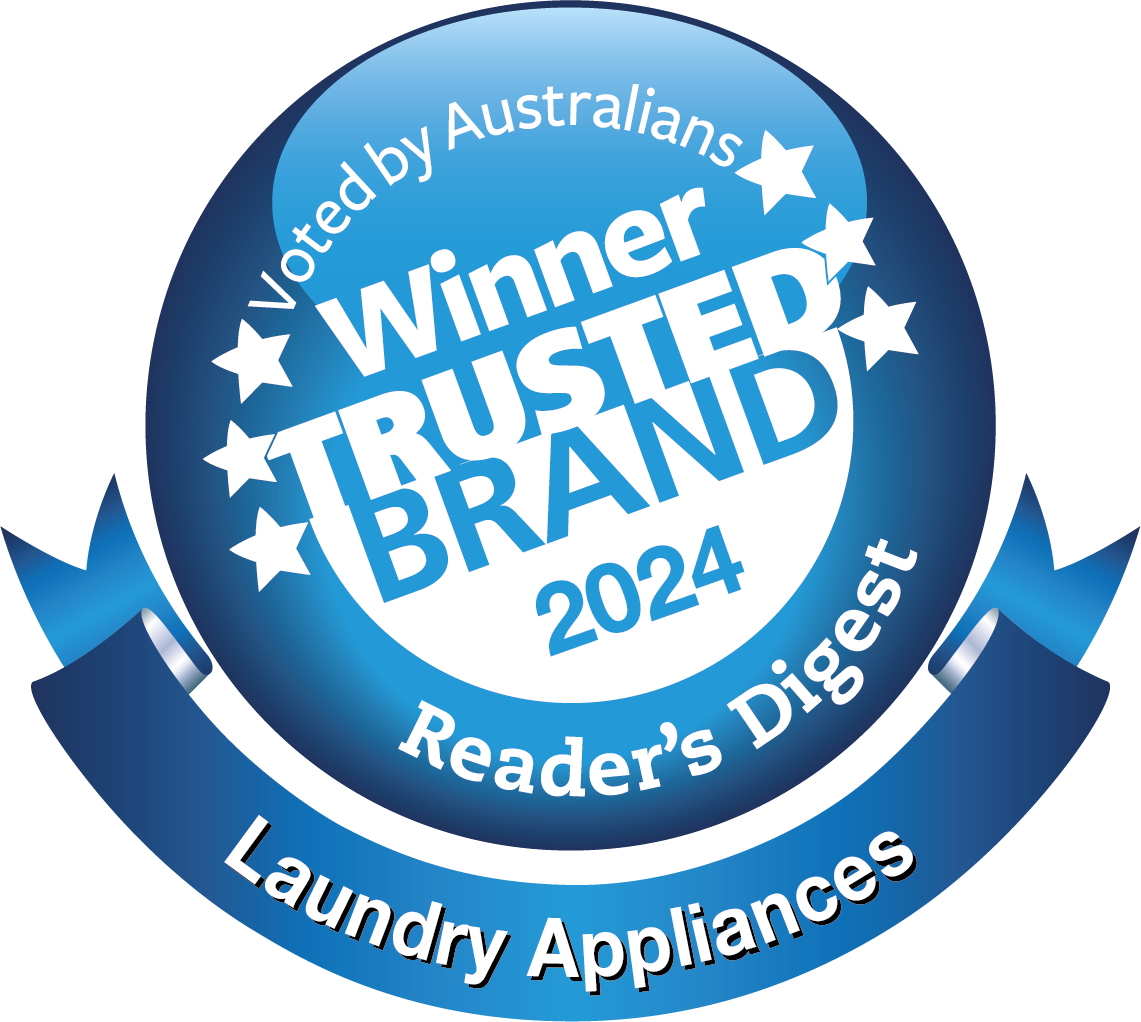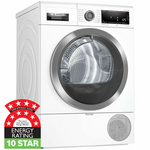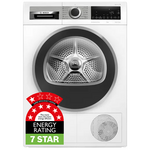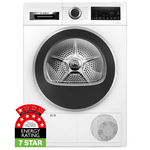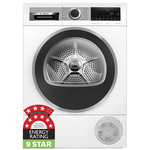
The 6 main reasons you might want to get a heat pump dryer
You need a new clothes dryer, and at first glance, it seems that vented dryers are the lowest-priced ones on offer. A second glance, though, might show that this older style of tumble dryer isn’t the best choice for you.
Whether you’re replacing an old vented or condenser model, or it’s the first time you’ve considered getting a clothes dryer, here’s a quick rundown of the key differences between the types of dryer available today, and why one type, in particular, stands out as the strongest contender for many homes.
4 types of dryer
When it comes to clothes dryers, you have four options: vented, condenser, gas and heat pump.
Vented tumble dryers
A vented dryer uses a continuously generated flow of heated air to evaporate moisture from wet clothes and then expels the moist air through a vent or exhaust duct, which needs external ventilation. The need for constant heat generation makes vented models less energy efficient than dryers that use newer technology.
Condenser tumble dryers
A condenser dryer heats up the air to dry laundry and then cools it to condense the moisture into water. The water is then collected in an internal water reservoir, and the air is re-heated and the process repeated a few times until the laundry is dry. While this process removes the need for ventilation, it’s fairly energy intensive, and condenser dryers have the same energy rating as vented models, with just two energy stars.
Gas tumble dryers
A gas dryer burns natural or LPG gas to produce the heat needed to dry laundry quickly and gently. Like vented dryers, they require external venting. They typically cost similar to some heat pump dryers, but may have additional set-up costs due to gas plumbing and ventilation requirements. It’s worth noting that some States, Territories and council areas are introducing restrictions in relation to new gas connections.
Heat pump tumble dryers
A heat pump dryer is a type of condenser dryer, but takes the technology a step further by using a heat pump system to recycle the hot air used for drying, while condensing the extracted moisture and collecting it in a water tank.
6 advantages of heat pump dryers
Here’s why you might want to choose a heat pump model for your next dryer.
1. It’s better for the environment
In a contest of vented vs condenser dryers, there’s not much between them in terms of their eco credentials. Add heat pump dryers into the mix, though, and you’ve got a hands-down winner for the most energy-efficient machine.
With between 6 and 10 Energy Stars, compared to the two stars of vented and condenser dryers (gas dryers are not Energy Star rated), the heat pump dryer is the champion of low energy consumption. It achieves these significant energy savings, and lower greenhouse gas emissions, by using a heat exchange process to reuse warm air, rather than continuously heat new air.
2. It costs less to run
Due to their lower energy use, heat pump dryers are much cheaper to run than more energy-intensive alternatives. A 7kg heat pump dryer, for example, could cost less than half as much to run as a 7kg vented dryer from the same brand.
The Australian Government’s ‘Standard Test’ for dryers gives Energy Ratings and running costs based on dryers being used once per week. In the case of these two dryers, that equates to about a $50 saving on annual electricity bills with the heat pump dryer. If you use the dryer twice a week, that becomes a $100 annual saving. If the heat pump dryer had cost you $350 more than the vented dryer, within three years or so, the amount you’d save on energy bills could cover the difference in cost between the machines.
3. It’s gentler on your clothes
Heat pump dryers are a lot more gentle on fabric than old-style dryers, with most cycles drying clothes more slowly at lower temperatures. Very low-temperature settings may also prevent the loss of colour sometimes associated with high-temperature drying.
The reduced friction can result in less damage to material, and a little less lint ending up in the lint filter than you might get with a vented dryer. By causing less wear and tear on material, and lowering the risk of shrinking delicate fabrics, the gentle drying process can help your clothes enjoy a longer lifespan than if they were dried in a vented dryer.
4. It doesn’t need an external air vent
No more steamy, humid laundry room! Traditional vented dryers should ideally have an external vent to expel damp air. This can be inconvenient to install, especially in apartments or homes without proper ventilation options.
Heat pump dryers don’t require external venting, making them a simpler option if you don’t already have ventilation set up, or you live in rental accommodation and can’t make structural changes. Without having to install ventilation or, alternatively, put up with the dryer pumping out humid air, you make life easier on yourself and reduce the risk of mould or mildew growth.
5. It can be quieter
Heat pump dryers can be quieter than vented and condenser dryers, thanks to the nature of the heat pump technology.
Vented dryers can be noisier due to the continuous generation of hot air and the fan used to expel the moist air. Similarly, the intermittent cycling of hot air generation and condensing in condenser dryers. Heat pump dryers, on the other hand, run at lower temperatures and use a more controlled and energy-efficient drying cycle, which can result in quieter operation.
6. It spoils you for choice!
Heat pump dryers may be the newest type of dryer, but they have quickly become very popular. Appliances Online, for example, stocks over 60 types of heat pump dryer from around 20 brands. By comparison, it stocks around 30 vented models and half a dozen condenser and gas dryers. This means, when it comes to choosing your new machine, you’re more likely to find a model in your preferred colour, capacity and style, and with the features you need, if you opt for a heat pump.
These are all great reasons for choosing a heat pump dryer, but in the interests of giving a fair and balanced picture, we should also consider any potential downsides.
Reasons you might not want to get a heat pump dryer
Even though heat pump dryers have a host of advantages, there are some aspects to them that mean they may not be the right type of tumble dryer for everyone.
It can be slower
On a regular cycle, heat pump clothes dryers take longer than vented machines to dry clothes. While many models have quick cycle settings that can dry a handful of items in around half an hour (that urgent sports kit or killer party frock), a full load can take a couple of hours or more.
However, because the slower drying time is due to the lower heat that’s used, the upside is that it’s gentler on your clothes, towels and bedding. Unless you always need your laundry to be washed and dried within an hour, a heat pump dryer can therefore be a better option for your wardrobe.
It can cost more to buy
It’s true that the purchase price of heat pump dryers is usually higher than for vented models, but you will always be able to find deals selling heat pumps for way below RRP - and remember that the lower running costs can offset the higher upfront cost over time.
You should also explore whether you are eligible for any rebates for buying a heat pump dryer. VIC and QLD have government incentives to switch to energy-efficient appliances. VIC offers modest rebates on a wide range of appliances: for upgrades to 7 Energy Star-rated heat pump dryers a $60 rebate is available. QLD has the most generous rebates on a number of appliances, with between $300 and $550 available for upgrading to a heat pump dryer (4 or more Energy Stars).
As of late 2023, other States and Territories don’t have rebates for heat pump dryers but do have incentives for energy-saving upgrades to a number of areas of the home, such as lighting, air conditioning, hot water systems, pool pumps, and insulation.
It can’t be wall mounted
You can’t wall mount heat pump or condenser dryers because, at between 50-70kg, they’re much heavier than vented models. They can, though, usually be stacked on top of front loading washing machines, using the correct stacking kits. This has the added benefit of positioning the dryer at a convenient height that doesn’t need you to bend over when loading or unloading laundry.
If you have a top loader washing machine that cannot have a dryer stacked on top of it, or the size and configuration of your laundry means the only type of dryer it can accommodate is one that can be wall mounted, a vented model would be the simpler choice.
Is a heat pump dryer right for you?
The type of dryer you choose will be partly down to preferences and partly down to the space in which it will be placed. If the size or layout of your laundry makes it hard to accommodate another appliance on the floor, and you can’t stack it for whatever reason, a heat pump dryer may not work for you. Similarly, if you always need a quick turnaround time with your laundry drying, or you have a lower budget (though remember that you’ll have lower energy bills if you choose a heat pump). If energy efficiency, lower utility bills or ventilation concerns are your top priorities, a heat pump dryer is the way to go.
Start saving on your energy bills sooner, with Free, Next Day Delivery* on heat pump dryers
Ready to upgrade to an energy efficient dryer? We deliver heat pump dryers, and the rest of our products, to 95% of Australia’s population for free with Appliances Online's legendary FREE delivery - and we can usually get it to you by the next day (Mon-Fri). Plus, we now offer paid Same Day Delivery in metro areas of NSW, QLD and VIC when you order before 12pm Mon-Fri. As part of our commitment to sustainability, we'll also take your old appliance away for recycling, for free. You can check out the full range of heat pump clothes dryers here, and if you have any questions, just call our friendly team 24/7 on 1300 000 500, or message us via the chat icon at the bottom right of your screen.
